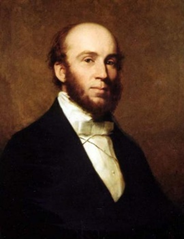Charles Piazzi Smyth
1819-1900
Was Astronomer Royal for Scotland for over 40 years. He was born in Naples in Italy, the son of Admiral William Henry Smyth and his wife Annarelia. He was given the middle name Piazzi after his godfather, the Italian astronomer Giuseppe Piazzi, a friend of his parents. On returning to Britain, the family settled in Bedford, where his father built an observatory and Charles Piazzi Smyth started to learn astronomy. As a 16-year-old he became an assistant to Sir Thomas Maclear at the observatory at the Cape of Good Hope, where he observed a number of comets and undertook other observations and calculations. In 1845, at the age of just 26, he was appointed Astronomer Royal for Scotland at the Calton Hill Observatory in Edinburgh, and also Professor of Astronomy in the University of Edinburgh. In 1856 Smyth married Jessie Duncan, daughter of Thomas Duncan, RA, the Scottish portrait painter. He spent their honeymoon making astronomical observations from the peaks of Tenerife in the Canary Islands to test the benefits of a mountain observatory. His new wife might have been slightly appeased by the fact that the Admiralty funded the trip, which was undertaken in the engineer Robert Stephenson's yacht Titania. The results were impressive and Smyth can be said to have pioneered today's practice of positioning telescopes on mountain tops to obtain better observations. In Edinburgh, he is best known for establishing the one o’clock time signal from the Nelson Monument on Calton Hill in 1852 and the firing of the gun from Edinburgh Castle that alerted the ships docked in Leith Harbour of the time. In the 1870s Smyth investigated the spectra of the aurora and began to become interested in weather forecasting. In 1878 he published the first map of the solar spectrum based on observations undertaken in Portugal. In 1888 Smyth resigned as Astronomer Royal for Scotland in protest at underfunding of the Calton Hill Observatory. His action prompted the establishment of a better funded and equipped Royal Observatory on Edinburgh's Blackford Hill, which opened in 1896. Smyth himself retired to Ripon in Yorkshire. However, he also became consumed with proving that the pyramids were a sign of divine intervention. His primary evidence was a special unit of length known as the pyramid inch, that allowed for numerical relations between the pyramids and the cosmos. Unsurprisingly, the Royal Society refused to publish the work and so did other journals. Smyth took this very personally and resigned from the prestigious association. He advocated for his theory for his entire life and was a stark critic of the metric system. While it may sound odd now, this theory was a major argument in the discussion for the metrication of the United States and the United Kingdom. Although Smyth’s life was filled with controversy, he is seen as one of Scotland’s most prominent astronomers. After his death, Smyth's theories on pyramid prophecy were then integrated into the works and prophecies of Charles Taze Russell, who founded the Bible Student movement (who adopted the name Jehovah's Witnesses in 1931, though Russell's successor, Joseph F. Rutherford, denounced pyramidology as unscriptural). Smyth's proposed dates for the Second Coming, first 1882 then many dates between 1892 and 1911, were failed predictions.
